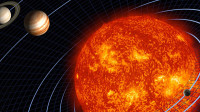Astrophysicists have found there is too much light in the space between galaxies and propose it is caused by decaying Dark Matter. …read more Read more here: creation.com
This paper documents the radioisotope dating data for more meteorites, so as to continue the discussion of the significance of these data. …read more Read more here: AIG Daily
Both the cosmic microwave background and the big bang model are fraught with problems. …read more Read more here: AIG Daily
Some big bang cosmologists end up with the conclusion they want to find simply by turning the evolution knob. …read more Read more here: creation.com
Is there too much helium in moon rocks for a young solar system? …read more Read more here: creation.com
Creationists continue to explore the possibilities of how God caused the cosmos to appear as it does. …read more Read more here: creation.com
After a ten-year-long flight, the European Space Agency’s (ESA) Rosetta spacecraft entered into orbit around a comet. It will soon attempt to actually land a probe on the comet’s surface. Though data-gathering has only just begun, the comet is already divulging secrets. More… …read more Read more here: icr.org
Detailed inspection of a Saturn moon now shows not just one, but 101 geysers shooting ice particles into space. If these geysers formed billions of years ago they should be old, cold, and dead—that is, completely inactive. Why aren’t they? More… …read more Read more here: icr.org
The latest conclusion from big bang cosmologists is that our universe doesn’t exist! …read more Read more here: creation.com
NASA promoters discussed the hope of discovering life on other planets at a recent meeting in NASA headquarters. Despite billions of dollars spent over the decades-long search and the fact that not one shred of distant life evidence has been found, NASA continues to suggest that life might really be out there and that its discovery is within reach. More… …read more Read more here: icr.org
Astrophysicists in damage control after big-bang ‘find’ doesn’t stand up to scrutiny. …read more Read more here: creation.com
Did the universe create itself from nothing? …read more Read more here: creation.com
The variety of exo-planets being discovered makes planet formation by dust-accretion even more unlikely. …read more Read more here: creation.com
The evolutionary theory cannot explain certain aspects of solar system bodies. There have been few comprehensive proposals for a creationary model. …read more Read more here: AIG Daily
Some of the most basic assumptions of the big bang should be under challenge from this discovery, but how it has been dealt with is a lesson for all. …read more Read more here: creation.com
Ph.D. astrophysicist and expert in black-hole–;containing galaxies explains why he believes in biblical creation …read more Read more here: creation.com
Nearly two years after the highly-publicized discovery of the elusive ‘God Particle,’ scientists have determined that the current Big Bang model cannot account for the existence of the universe. As previously reported, scientists in Europe announced in 2012 that they had detected the Higgs boson, then confirmed their findings last year. The Higgs boson, also known as “the God particle,” was widely heralded as a key to understanding the origins of the universe. However, in a major setback to the secular Big Bang theory, scientists with King’s College in London announced this month that Higgs boson physics cannot account for [More]
One of the common objections to biblical creation is that scientists have supposedly demonstrated that the universe is much older than the Bible teaches. …read more Read more here: AIG Daily
Hugh Ross praised latest Big Bang inflationary theory claims but-weeks later-evolutionists admitted they got it wrong. …read more Read more here: creation.com
In March 2014, a team of radio astronomers announced purported direct evidence for inflation, an important part of the Big Bang model. But only two months after this “discovery” a number of secular scientists have become increasingly skeptical. More… …read more Read more here: icr.org
New evidence confirms that, like Earth, Saturn’s magnetic field helps create its own auroras. This space spectacle attracts a more fundamental question about where its magnetic field came from in the first place. More… …read more Read more here: icr.org
Are the chemical signatures in a faint galaxy the fossil remnants of our universe’s birth? …read more Read more here: AIG Daily
A research physics professor, Dr John Hartnett points out how Scripture’s version of events differs completely from the big bang/long-ages model and defends creationist claims of problems with ‘inflation’. …read more Read more here: creation.com
It’s not a planet, nor a comet, but the faraway object named 2012 VP113 now joins Sedna as the second member of what secularists term the “inner Oort cloud.” This “cloud” presents a mystery—these objects should not even be there. How could they have traveled there, and what do they really represent? More… …read more Read more here: icr.org Category: Creation Science Update
Astronomers have developed an elaborate, physically robust evolutionary theory to explain the abundances that we see throughout the universe. While this theory may be explanatory, it has no predictive power. …read more Read more here: AIG Daily
The mystery of the moon’s age is supposedly solved by computer simulations. …read more Read more here: AIG Daily
Episode 8 of Cosmos mingles fascinating physics and astronomy with evolutionary interpretations that cannot be tested or observed. …read more Read more here: AIG Daily











































